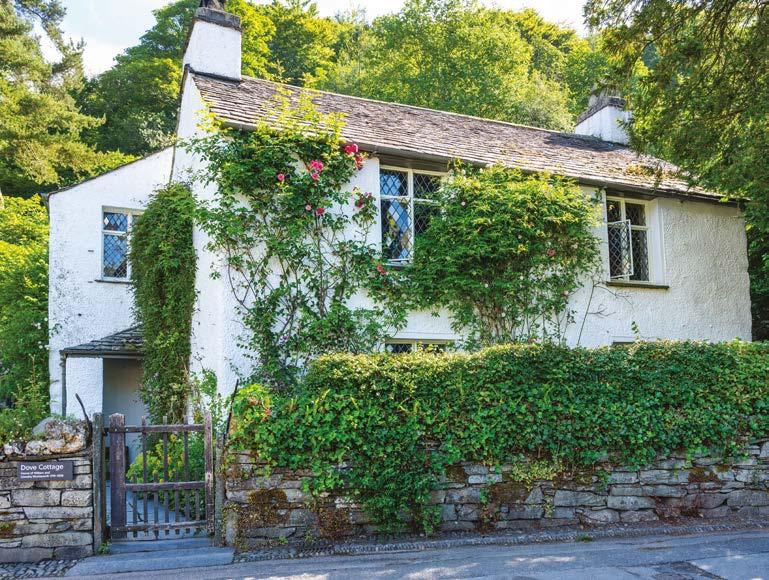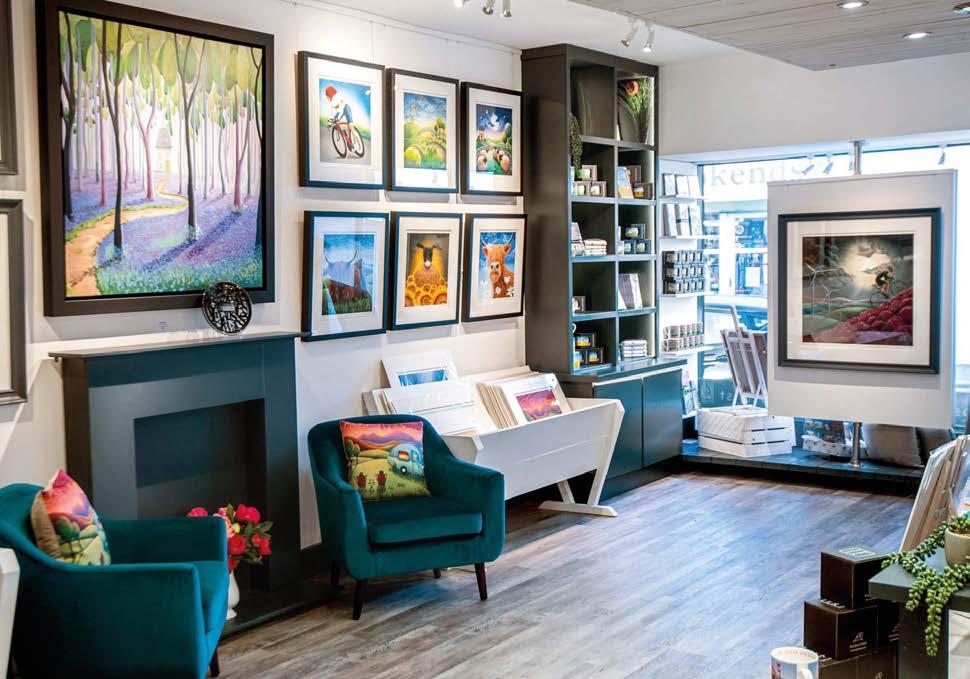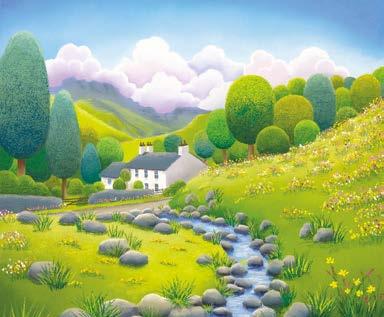
11 minute read
ROMANCING THE LAKES

Follow a literary trail around Windermere and Grasmere, jewels in the crown of the magnificent Lake District

WORDS NATASHA FOGES
There’s something about the Lake District – something that sparks the imagination and soothes the soul. A picture-perfect expanse of rugged peaks, placid waters and rolling farmland, neatly divided by dry-stone walls and dotted with stone-built villages, northwest England's Lake District has the double accolade of being both a UNESCO World Heritage Site and a National Park. Walkers wax lyrical about its famous fells (as the hills and mountains are called here), but it’s just as rewarding to explore it in a more leisurely way – perhaps following the trail of two literary lights who found inspiration here a century apart.
One of the area’s most famous devotees was Beatrix Potter, the much-loved children’s author who escaped the constraints of Kensington and found peace in a cottage above Windermere. A century earlier, the Romantic poet William Wordsworth spent his most prolific years in Grasmere. The lakes of Windermere and Grasmere are just three miles from each other, connected by regular buses, so it’s easy to plot a route through the romantic landscapes that inspired these great writers, and visit their wonderfully evocative homes.
Our tour begins around Windermere, the biggest of the area’s 16 lakes, at over ten miles long. It has long been the most popular of the Lakes, ever since the arrival of the Kendal and Windermere rail line in 1847. Wealthy families built holiday homes overlooking the water and took steamers across the lake to admire the scenery. This excursion is now provided by Windermere Lake Cruises, whose steamer-style vessels and modern launches glide up and down the lake.
From the deck you can spot the mock-Gothic Wray Castle on the western shore, where Beatrix Potter and her family spent their first summer in the Lake District in 1882. A new exhibition at the castle displays the photographs of Rupert Potter, Beatrix’s father, which reveal a passion for the local nature that he passed onto his daughter. Beatrix spent her days sketching the mountains, woodlands and flowers: the first glimmer of a love for the landscape that would last for the rest of her life. Many happy summers followed, and Beatrix’s holiday sketches evolved into picture stories for her family and friends. The tales featured a mischievous rabbit named Peter, a hedgehog named Mrs Tiggy-Winkle and many other lovable creatures. The Tale of Peter Rabbit was published in 1901, and with the proceeds Beatrix bought herself a holiday home above Windermere. Hill Top, a small working farm with a rambling cottage garden in the village of Near Sawrey, provided inspiration for many of her famous stories. Step into the simple farmhouse and it is as if its one-time owner has just left the room: a fire crackles in the grate and Beatrix’s clogs sit neatly under a chair. All of the furniture is hers, from the willow-pattern plates displayed on the scrubbed oak dresser to the grandfather clock ticking
Previous page: Grasmere is one of the smallest lakes, and is set in a beautiful landscape Opposite: Wray Castle, which sits on the western shore of Lake Windermere, is where Beatrix Potter and her family holidayed in 1882




Top:Hill Top, where Beatrix Potter wrote and illustrated many of her famous tales, was left to the National Trust Above left and right: Visitors to the farmhouse can see how the author lived and worked Opposite: Take a lake ferry across Windermere from the Waterhead Pier in Ambleside cosily in the corner. The parlour is a surprising contrast, with its elegant furniture and marble mantlepiece: a reminder that, while Beatrix immersed herself in country life, her background was in the wealthy middle classes.
The informal cottage garden is a delight, immediately recognisable from Beatrix’s famous illustrations. You can imagine Peter Rabbit hopping up the flagstone path in search of cabbages, and Jemima Puddle-Duck laying her eggs in the rhubarb patch.
In 1913 Beatrix married local solicitor William Heelis and moved to nearby Castle Cottage, but she kept Hill Top as a place to work, entertain and display her collections. Beatrix left Hill Top to the National Trust on her death, stipulating that it was to be preserved as she left it – a large part of its charm.
At the Beatrix Potter Gallery in the pretty village of Hawskhead, you can get up close to illustrations of her
THE MYTHICAL TIZZIE-WHIZIE
When tourists first began to arrive in the Lake District at the end of the 19th century, the boatmen of Bowness-in-Windermere, the main town on the lake, spotted an opportunity. They informed tourists that a creature called the ‘Tizzie-Whizie’ could be seen around the lake, encouraging them to pay for boat rides to spot it. The creature was shy and water-loving, they said, with the body of a hedgehog, the antennae of a bee and a fluffy tail like a squirrel.
To silence any doubters, they produced a ‘genuine photograph’ of the mysterious creature, which had supposedly been lured to the photographer’s studio with ginger biscuits. Thousands of postcards of the image were printed and sold by the Bowness boatmen on their popular Tizzie-Whizie hunts: the tourists’ only real chance of seeing the elusive creature.


Grasmere is best known for its association with Wordsworth, who declared it ‘the loveliest spot that man hath ever found’
Left to right: Dove Cottage was the Wordsworth siblings' first home in Grasmere; the poet's final resting place is the graveyard of the village's St Oswald's Church; the Lake District's rich boating history is celebrated at Windermere Jetty Museum beloved characters, and follow the story of Beatrix’s evolution from children’s author to passionate conservationist: upon her death, Beatrix left 4,000 acres of land in the Lake District to the National Trust in order to save it from development.
Before leaving the lake, stop off at the wonderful Windermere Jetty Museum, which celebrates the rich history of the Lakes with a world-class collection of boats. You’ll find an array of special vessels here, from Beatrix Potter’s ramshackle rowing boat, made of old floorboards, to record-breaking speed boats and the collection’s flagship, the dazzling steam launch Branksome, built in 1896. Fitted out with walnut panelling, velvet upholstery and a silver tea service, it’s one of the finest Victorian steam launches in the world, meticulously restored in the on-site conservation workshop. You can even join a cruise on one of the museum’s gleaming Edwardian launches too.
From Windermere, travel winding lakeside roads to beautiful Grasmere, the lake best known for its association with the poet William Wordsworth, who famously declared it ‘the loveliest spot that man hath ever found’.
Recently opened after a £6.5m reimagining, Wordsworth Grasmere incorporates Dove Cottage, where the poet moved in 1799 with his sister Dorothy. Wordsworth was inspired to write many of his best works here, while Dorothy penned her Grasmere Journal, a vivid chronicle of their daily life. The cosy cottage, with its stone floors, dark-panelled rooms and glowing fires, transports you back to the time when it was a bustling family home,
STEVE TAYLOR ARPS/ALAMY/COLIN PALMER PHOTOGRAPHY/ALAMY/WINDERMERE JETTY MUSEUM © PHOTOS:
while you can explore handwritten manuscripts, journals and letters in the excellent museum next door.
En route to the Wordsworth family’s next home, Allan Bank, follow your nose to the Grasmere Gingerbread Shop, where the spicy-sweet treat was invented in 1854; the store has barely changed in the years since. Before establishing as a shop, the building housed the village school, where Wordsworth once taught.
It was at Allan Bank, a handsome Georgian villa with views over Grasmere, that Wordsworth began his Guide to the Lakes (1810), in which he first mooted the idea of ‘a sort of national property’ that everybody ‘had the right to enjoy’, long before the existence of national parks. It was well over a century before the Lake District eventually became one, thanks to the efforts of a later resident of the same house, Canon Hardwicke Rawnsley. One of the three founding members of the National Trust and a passionate campaigner for conservation, Rawnsley – aided by his great friend, Beatrix Potter – was instrumental in preserving the Lake District.
Allan Bank was left to the National Trust in 1951. When a terrible fire ravaged the interior in 2011, rather than restoring it, the Trust left its walls bare and its rooms empty. It’s now a historic house with a difference, with comfy chairs in which to sit and take in the views with a cup of tea – something of which Wordsworth would approve: he spent a small fortune shipping chests of



Twinings tea from London.
Just three short years later the Wordsworth family moved again, this time to Rydal Mount, another pictureperfect house in a delightful garden. Set above Rydal Water, a slip of a lake between Grasmere and Windermere, the house was Wordsworth’s home for 37 years until his death in 1850. Wordsworth wrote the immortal lines ‘I wandered lonely as a cloud’ here (Daffodils, 1815) and landscaped the wonderful Romantic-style garden. Still crammed with his furniture and possessions, from his inkstand and quill to the picnic box he took on rambles, Rydal Mount embodies the spirit of the poet.
‘I often ask myself what will become of Rydal Mount after our day’, mused Wordsworth in 1840. He might, indeed, have also wondered about the fate of the wider Lakeland landscapes that he so loved. Thanks to his early campaigning, the pioneering work of Beatrix Potter and the efforts of the National Trust, the Lake District is wonderfully unchanged – and is still inspiring poets, ramblers and dreamers alike all these years later.
THE PLANNER
GETTING THERE Great Western Railway runs direct services to Oxenholme Lake District from London Euston (2hr 40min). From here, you can catch a train to Windermere (20min). Stagecoach runs a regular bus service in the area, while Windermere Lake Cruises offers boat trips. www.gwr.com; www.stagecoachbus.com; www.windermere-lakecruises.co.uk
WHERE TO STAY Rothay Manor is ideally sited between Windermere and Grasmere in the pretty town of Ambleside. Plump for one of the eight suites in the new Pavilion, which are spacious and stylish, with generous bathrooms. www.rothaymanor.co.uk
WHERE TO EAT AND DRINK Rothay Manor has two restaurants: a fine-dining option with a refined eight-course tasting menu, and an informal bistro, with local produce such as Cumbrian lamb and cured chalk stream trout on the menu. Destination restaurant The Forest Side grows many of its own ingredients and is known for unusual flavour combinations. The Cuckoo Brow Inn is an unpretentious pub near Hill Top, while the cosy Hole in t’ Wall in Bowness dates back to 1612. www.theforestside.com; www.cuckoobrow.co.uk; holeintwall.co.uk
FURTHER INFORMATION Visit the Lakes’ visitor centre, Brockhole, for more on the area’s history, activities and events. www.brockhole.co.uk; www.visitlakedistrict.com
Above:As well as inspiring William Wordsworth, Grasmere is where gingerbread was invented in 1854 Left: You can cruise across Lake Windermere in style aboard a classic steamer-style boat
UK’s Most Popular Published Artist 2022

Lucy’s love for the Lakes started at a young age and it is one of her favourite places. From regular holidays as a child, she now visits with her own family choosing to spend time at their caravan in Keswick, exploring some of the best scenery you can find. It is this longstanding love affair with the lakes and her time spent in Keswick that has inspired new works of art in a dedicated collection showcasing this wonderful region through the seasons.
Well known across Yorkshire, the North-East and beyond for her naïve and imaginative art, Lucy has one goal; create art that makes you smile, and her signature sheep art is some of her most recognisable work. Lucy uses soft pastels on board to create bright and uplifting artwork. Each piece has a real-life story behind it inspired by the sights, sounds and events in her own life including family, surroundings and those closest to her.
As the ‘UK’s Most Popular Published Artist 2022’ awarded by the Fine Art Trade Guild, Lucy is a multi-award winning artist, proudly running a family-owned business with beautiful art galleries and a successful e-commerce website serving customers around the world offering stunning original works of art, Giclee prints and striking canvases as well as ceramics, textiles, and stationery; making beautiful gifts or additions to any home.
Lucy’s full body of work can be viewed online at www. lucypittaway.co.uk or in one of her galleries where her signature sheep art plus other wonderful collections are available including the Lakes Collection, Staycation and the highly successful Cycling collections.













